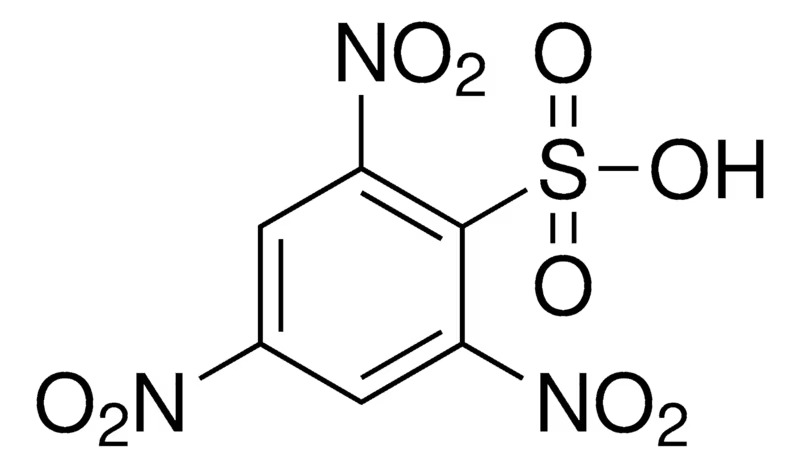Sigma-Aldrich 2,4,6-Trinitrobenzenesulfonic acid solution, TNBS
Catalog No :
CAS Number :
Brand :
In Stock
5 % (w/v) in H2O, BioReagent, suitable for determination of primary amines
Specifications:
| Application | Colorimetric Assay, Organic Synthesis | ||
| Storage Temperature | Ambient | ||
| Product Type | Laboratory Chemical | Forms | Liquid |
| Product Brand | Sigma-Aldrich | ||
| Product Grade | Analytical grade | Formula | C₆H₃N₃O₉S |
2,4,6-Trinitrobenzenesulfonic acid solution (TNBS), also referred to as picrylsulfonic acid solution, is a water-soluble, chromogenic reagent widely used in biochemical, immunological, and pathological studies. TNBS functions as a hapten—a small molecule that binds to proteins and renders them immunogenic by forming hapten-protein conjugates. This property makes it an important tool in studies of delayed-type hypersensitivity (DTH), colitis models, and immune responses in animals.
Chemical and Physical Properties
| Property | Value |
|---|---|
| CAS Number | 2508-19-2 |
| Empirical Formula | C₆H₃N₃O₉S |
| Molecular Weight | 293.17 g/mol |
| Concentration | 5% (w/v) in water |
| Grade | BioReagent; suitable for determination of primary amines |
| Product Line | EMSURE® |
| Storage Temperature | 2–8 °C |
| Form | Aqueous yellow solution |
| Quality Level | 200 |
| SMILES | OS(=O)(=O)c1c(cc(cc1N+=O)N+=O)N+=O |
| InChI Key | NHJVRSWLHSJWIN-UHFFFAOYSA-N |
Applications
1. Primary Amine Detection
- TNBS reacts with primary amines (e.g., lysine residues in proteins), forming a chromophore that can be quantified spectrophotometrically.
- Suitable for detecting modifications in proteins such as carboxymethyl lysine (CML).
2. Immunology & Hypersensitivity Research
- TNBS acts as a hapten, binding to tissue proteins and inducing a T-cell-mediated immune response.
- Used in animal models to induce colitis, contact hypersensitivity, or delayed hypersensitivity.
- Facilitates research into inflammatory mediators such as LTB4, 5-HETE, 12-HETE, and 15-HETE.
3. Embryology & Cell Labeling
- Used in zona-intact bovine embryo staining for blastocyst differentiation.
4. Gut Microbiome & Inflammation Studies
- TNBS is applied to simulate irritable bowel syndrome (IBS) or inflammatory bowel disease (IBD) in murine models to evaluate probiotic therapies like Clostridium butyricum.
Biochemical/Physiological Action
- TNBS binds to primary amino groups of proteins, forming haptenated proteins which are then recognized as antigens by the immune system.
- In colitis models, it generates a Th1-mediated immune response mimicking aspects of human IBD.
Pack Sizes and Ordering Information
| Pack Size | SKU / Product Code |
|---|---|
| 10 mL | P2297-10ML |
| 5 × 10 mL | P2297-5X10ML |
Handling and Safety Information
| Hazard Classification | GHS Pictogram |
|---|---|
| Acute Toxicity | ☠️ GHS06 |
| Environmental Hazard | 🌿 GHS09 |
| Health Hazard | ⚠️ GHS08 |
- UN Number: Not typically regulated at 5% concentration, but follow lab safety protocols.
- Use personal protective equipment (PPE) including gloves, lab coat, and safety goggles.
- Work in a fume hood when handling concentrated forms or preparing derivatives.
Sigma-Aldrich’s 2,4,6-Trinitrobenzenesulfonic acid (TNBS) solution is a valuable reagent for researchers studying immune responses, protein modification, and inflammatory models. Its high reactivity with primary amines, ease of use, and reliable colorimetric properties make it ideal for both qualitative and quantitative biochemical assays. With broad relevance in immunology, molecular biology, and toxicology, TNBS remains a cornerstone reagent in experimental protocols requiring immune modulation or amine quantification.
- Pack Size: 5 X 10 mL 10 mL




 0
0
